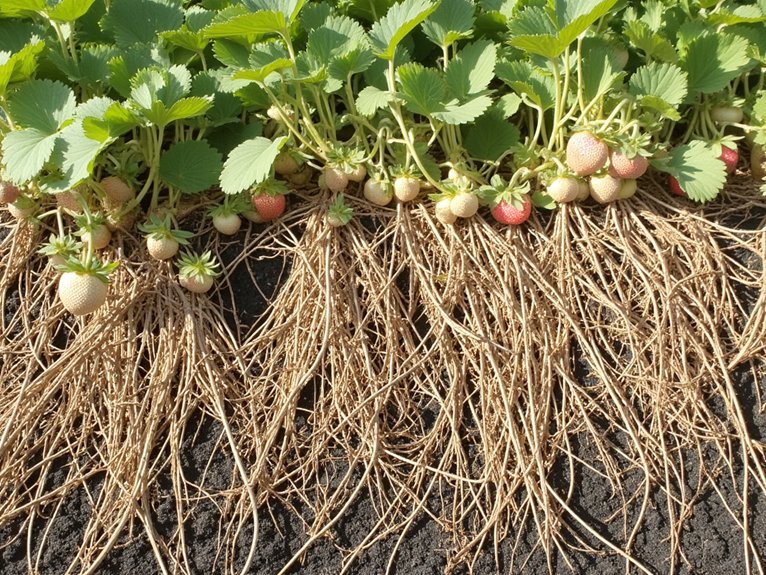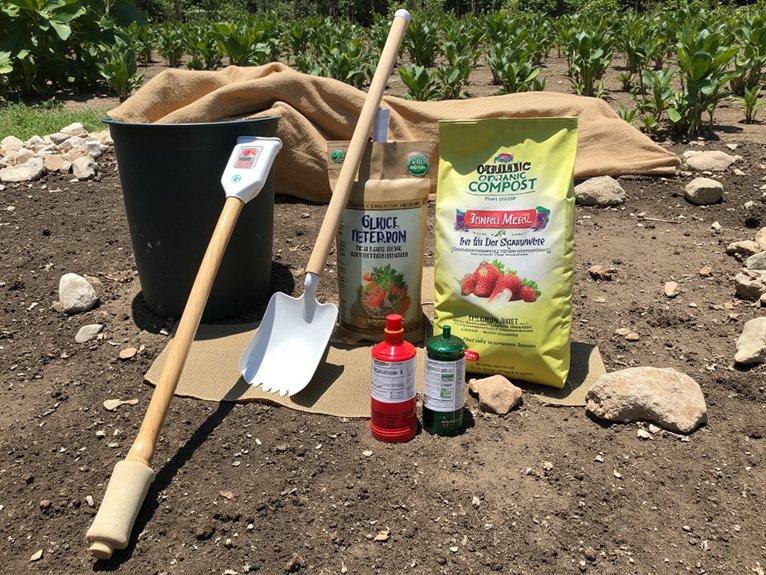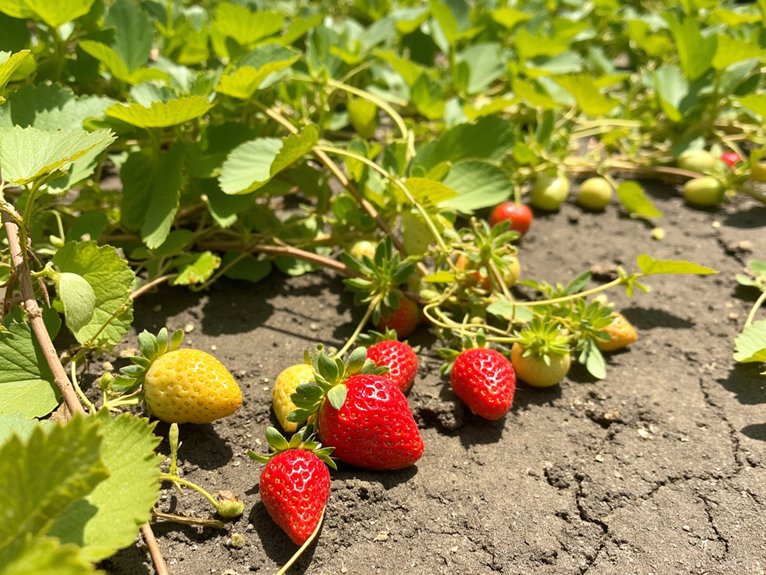You’re about to discover the proven techniques for growing sweet, juicy strawberries right in your backyard. Whether you’re starting with bare root plants or nursery transplants, proper planting makes all the difference in your harvest success. As master gardener Sarah Thompson notes, “The first two weeks after planting determine your entire season’s yield.” Let’s uncover the essential steps that’ll transform your garden into a thriving strawberry patch.
Contents
What Makes Bare Root Strawberries Different

While they may not look like much at first glance, bare root strawberries are dormant plants that consist of just the crown and roots without any soil attached. These hardy plants offer several bare root benefits that’ll make your gardening easier. They’re lighter and more compact for shipping advantages, which means you’ll save on delivery costs. You’ll also find they’re easier to inspect for quality and disease before planting. Even without visible sprouts, these resilient plants are ready to grow once you plant them properly in your garden or containers.
Choosing the Right Strawberry Variety for Your Garden
When selecting strawberry varieties for your garden, you’ll need to take into account your climate, growing season, and intended harvest schedule.
There are three main strawberry types to evaluate:
- June-bearing: One large harvest in early summer, ideal for preserving
- Ever-bearing: 2-3 harvests throughout the season, perfect for continuous fresh eating
- Day-neutral: Steady production all season, great for small spaces
Each type offers distinct flavor profiles and growing patterns. June-bearing varieties like ‘Earligrow’ deliver intense sweetness, while ever-bearing ‘Ozark Beauty’ provides reliable harvests. For year-round production, try day-neutral ‘Albion’ with its balanced sugar-to-acid ratio.
Essential Steps Before Planting Your Strawberries

Before you plunge into planting your bare root strawberries, proper preparation will set you up for success in the growing season ahead. Begin by examining your bare root plants for signs of mold or damaged roots, trimming away any unhealthy sections.
For ideal root health, consider these essential steps:
- Soak roots in water for 1-2 hours to rehydrate
- Prepare well-draining soil enriched with compost
- Test soil pH (aim for slightly acidic, 5.5-6.8)
- Create planting holes 6 inches deep
- Remove rubber bands from bundled plants
“Proper soil preparation is vital for establishing healthy strawberry roots,” notes garden expert Jane Smith.
Mastering the Perfect Planting Technique
Once you’ve prepared your planting site, mastering the proper planting depth becomes essential for your strawberry plants’ success. Here’s how to get it right:
- Dig a 6-inch hole using a garden trowel
- Spread the roots downward in a fan shape, avoiding any “J-rooting”
- Position the crown so its top sits slightly above soil level
- Cover the bottom two-thirds of the crown with soil
- Gently firm the soil around the roots
“The crown should be visible above ground – think of it as the plant’s collar,” explains master gardener Sarah Chen. “Too deep, and it’ll rot; too shallow, and the roots will dry out.”
Common Mistakes to Avoid When Growing Strawberries

Despite the seeming simplicity of growing strawberries, many gardeners make significant mistakes that can greatly impact their harvest. Here are the most common pitfalls to avoid:
- Planting the crown at the wrong depth – bury only ⅔ of the crown to prevent rot
- Inconsistent watering – use soaker hoses or drip irrigation for steady moisture
- Ignoring strawberry pests like slugs and birds – install netting and maintain regular inspections
- Overcrowding plants – space them 18 inches apart for proper airflow
- Poor soil preparation – amend with compost before planting
“Proper spacing and consistent watering techniques are essential for preventing disease and ensuring maximum yields,” notes agricultural expert Dr. Sarah Chen.
Tips for Long-Term Success and Maximum Yields
To achieve consistent harvests year after year, successful strawberry gardeners must focus on long-term maintenance strategies that maximize plant health and fruit production. “The key to abundant strawberry yields lies in establishing good cultural practices from the start and maintaining them religiously,” explains horticultural specialist Dr. Jane Smith.
Start with proper strawberry mulching, using clean straw or pine needles to suppress weeds and retain moisture. Implement a thorough pest management program, checking plants weekly for signs of insects or disease. Remove runners promptly from ever-bearing varieties, and renovate June-bearing patches annually after harvest. You’ll need to replace plants every 3-4 years when productivity declines.
